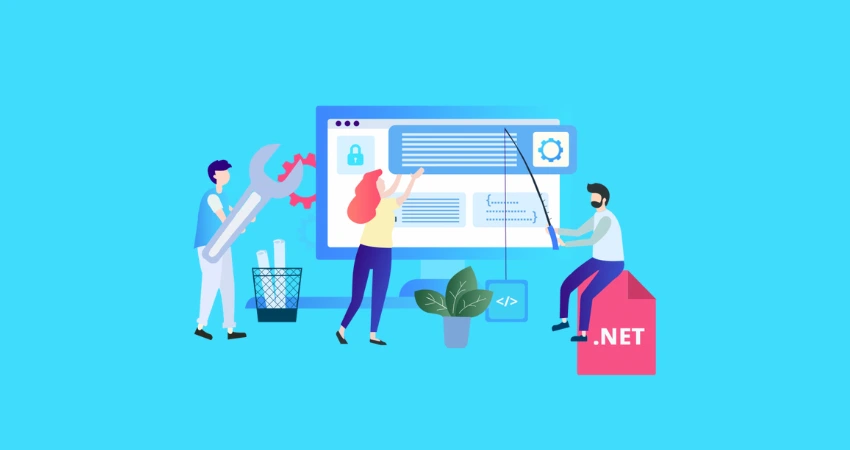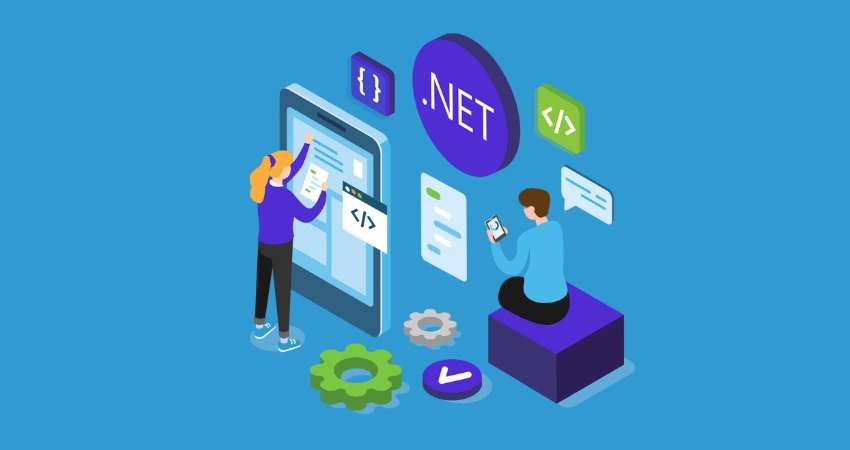Is .NET Extinct? | What exactly is .NET?
Is it true that .NET is no longer in use? To begin, what exactly is .NET? Microsoft’s. NET programming framework is used to construct online and mobile apps. Frameworks allow developers to call in code without having to write it themselves. .NET frameworks are commonly used to connect to online services, databases, and communication tools. I’d think it’s rather beneficial. Some have stated that the.NET framework is outdated due to the influx of new technologies coming out of Silicon Valley. On the other side, there are many .NET supporters who are optimistic about the framework’s future. We’ll discuss both sides of the debate and explain why the Bay Area continues to use it. NET.
Is .NET Dying? | Why Do Some People Think It Is?
“Why did I leave.NET?” says Jonathan Oliver, the maestro of the dev world. In a nutshell, it limited our power to select (which is a major thing for me) and focused our attention inward toward the imagined safety of the nest rather than allowing us to experience all of the options out there in the vast, wide world.”
So, is .NET doomed? NET is obviously associated with a negative connotation. It’s possible that the sigma is related to certain coders’ dislike of Microsoft in general. Many people believed that the technology had become obsolete as more open-source alternatives became accessible. Microsoft learned about this and now makes the entire server stack available as open source.
So, what is the purpose of .NET? Using a Windows framework, rather than a developer’s perspective, has the potential to confine the market for app installations because the software will be installed primarily by Windows users. There are also other fees, such as SQL Server, Windows loyalty, and upgrades.

An Oldie but a Goldie
It’s hard to think that .NET is still relevant in the age of ever-changing and ever-evolving technology. It’s a bit of a tech dinosaur that’s been around for more than 15 minutes. .NET, on the other hand, is worthless if it isn’t relevant in Silicon Valley and beyond.
The entire .NET server stack is now open source, as previously stated. ASP.NET, the Dot NET compiler, the .NET Core Runtime, Framework, and Libraries are all included. This enables developers to use .NET not just on Windows but also on Mac and Linux. Apps may now be written on any OS utilizing Microsoft’s new open-source code editor, Visual Studio Code, since. resurgence NET’s in the open-source arena.
.NET is a highly scalable and powerful technology that uses Managed Code to give a high level of tolerance right out of the box. The CLR manages the assembly of your program into native executable code when it is run. This implies that the CLR gives you some assurance about how your software works, which improves its security and capacity.
Is it true that .NET is no longer in use?
Is it true that .NET is no longer in use? No. Because of its extensive functionality,.NET was (and continues to be) quite popular. Some firms have the financial resources to totally rewrite existing products in new languages, but many do not. Maintaining a framework is significantly easier and less expensive than developing a new one, as any corporation with a limited budget will tell you. Companies in the Bay Area are looking to Zibtek to sustain their core products so they may concentrate on new development. This also allows Bay Area tech businesses to implement new features without diverting senior-level personnel’s attention away from the overall business.
What is the purpose of .NET?
While it is far from new,.NET remains a viable option for online and mobile development, which is why so many San Francisco developers continue to use it. It’s fantastic to try out new, fashionable technologies, and as a development firm, we want to discover new things, but what’s popular doesn’t always stop what’s trustworthy. the .NET community is growing at a breakneck pace, especially now that the technology is open source and brimming with seasoned .NET engineers.

.Net’s future is bright. The core of the Internet
With the writing on the wall indicating that no one wanted to pay license fees to use a programming language, Microsoft changed tactics. Opensource alternatives in Python, Node, and Java defeated Microsoft in the war for domination.
Kestrel, the webserver used by ASP.Net Core, allows programmers to run an application on Linux or MAC systems just as simply as on Windows servers. The is the. The Net Core platform is also compatible with macOS, Linux, and Windows.
The majority of the software, including the C# language, has been open-sourced by the corporation. Microsoft published the first version of.Net Core in 2016, and it is on the verge of displacing its legacy. Net. Additionally, Net Core has built-in support for Angular and React JS, making web development simple, modular, and feature-rich. Using dependency injection, you may eliminate hard-coded dependencies between classes.
One last point to consider
Older versions of .Net are used in a lot of legacy applications. For many businesses, migrating to .Net Core makes more sense because the syntax is identical, making retraining current team members on the technology much easier than transitioning to a new platform. Many businesses might benefit from an ASP.Net Core conversion rather than a full rewrite of their software in terms of cost and timing.
Is the.NET Framework truly defunct?
Microsoft said in 2019 that the.NET Framework 4.8 will be the final version of the framework. The successor to.NET Core 3.0 will be named as.NET 5.0, according to the firm. In other words, the.NET Framework would be replaced by.NET Core. Dot NET 5.0 was finally released in November 2020. It does not, however, provide all of the capabilities that the .NET Framework did at the time of publication.
Microsoft’s goal with .NET 5.0 is to turn .NET and Dot NET Core into a new cross-platform foundation. There are, however, certain disadvantages. For years, developers have used ASP.NET Web Forms to create web interfaces. On .NET 5.0, it is no longer supported. You’d have to use Blazor instead. Even the conventional Windows communication foundation, Windows Communication Foundation (WCF), is being phased out. As a result, you’ll have no choice but to use alternative solutions like gRPC or CoreWCF. As a result, there is no major technical debt with older programs that use the .NET Framework.
Overall, Microsoft is making significant modifications to the.NET and Core frameworks in order to bring them closer together. As a result, you won’t be able to use the major functions like you could on the original platform. In this sense, the.NET Framework is no longer relevant.

A big number of engineers throughout the world were enraged by Microsoft’s controversial action on the.NET framework. They believe there is a large gap between release and stability in the software development behemoth’s products.
On the flip side, this framework also had a few versions such as Silverlight which didn’t work up to expectations and forced us to look for other solutions.
In 2019, Microsoft announced that .NET Framework 4.8 will be the final version of the framework and declared dot NET 5.0 as the successor of .NET 3.0. Now, let’s look at the experts’ opinions on whether the .NET framework is really dead.
Feel a gap exists between the release & sustainability of the Microsoft products
“In 2019, Microsoft declared that the .NET Framework 4.8 was the last among the .NET Framework. Furthermore, they announced that the .NET Core 3.0 would be referred to as .NET 5.0. Thus, .NET Core replaced .NET Framework.
It is important to note that .NET 5.0 does not support the use of ASP.NET Web Forms in building web UIs. Additionally, you cannot use Windows Communication Foundation (WCF). Instead, you have to use Blazor and other alternatives like CoreWCF, meaning there is a gap in the apps’ built-in .NET Framework.
Developers, therefore, feel a gap exists between the release and sustainability of Microsoft software products.
“Yes, the .NET framework is dead. It is dead because it will never update or come out with anything new again – and it already hasn’t for a year. Though it may receive some security updates, its features will never update. Microsoft announced back in 2019 that it would be releasing its last ever framework, so the company itself announced its end. Luckily, there are lots of alternatives out there, like Delphi, Java, Python, Node, and more.”

“The .NET framework appears to be dead, for several reasons. First, its last release was in 2019, over two years ago. Second, its successor, .NET 5.0, had a rollout that was confusing and actually infuriating to web developers globally as a matter of fact. The main reason behind that is that those developers felt that there was a gap existing between its release and its stability. Developers, among others, were basically left guessing for the most part.”
“.NET is dead as a future framework for web applications and software. Microsoft won’t be building for it and they won’t support it. But software that already runs on .NET and is no longer being updated will still run on it. You just may have to use an older operating system in the future to get these programs to work.
All of that said, Microsoft will replace .NET with something functionally similar. Of course, this puts the burden on developers to update their applications so that newer operating systems can run them.”
